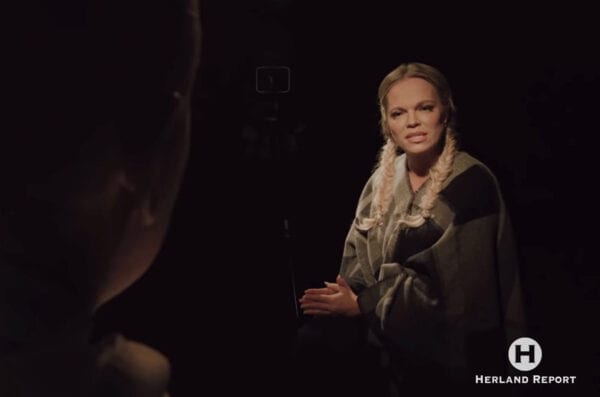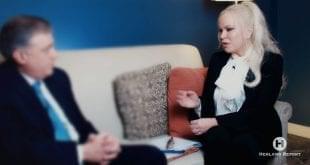Herland Report: Herland Report TV host, Hanne Nabintu Herland speaks to Kjell Arild Pollestad about the brutal Viking age, Christian Kings, Harald Hardrada, St. Olaf Haraldsson and the making of Norway. Watch it here!

“I feel privileged that in this globalized society, I have found the foundation in the Christian faith,” says Padre Kjell Arild Pollestad, an author of many books.
“I feel it is a privilege to know where we are going, and where we come from. I can say with great Christian author in Norway, Sigrid Undset who got the Nobel Prize, “I have lived for a thousand years in this country”, so have I.”
The old Viking culture was famously expanding from the time period of 750 till 1100 AD. We know this period now from TV series such as Game of Thrones and Vikings.
As proud Scandinavians, we therefore set out to make a VIKING TV series about our heritage. Follow The Herland Report new VIKING series that focuses on the old Viking culture.
Our VIKING series tells the tale of the spectacular Viking age and its Norwegian kings: Harald Hardrada, Olav Trygvasson, Olav the Saint, their friends in Russia, Constantinople, the conquest of England in 1066 AD and the rise of Orthodox Christianity in Scandinavia.
Author Kjell Arild Pollestad says: “When you know all that the Christian faith has given to our cultural history, both as in its Catholic and Protestant form, it is very valuable.”
“I believe that if people have these roots, they will live much easier and also receive people of different heritage, since they are strong in their own foundation. For example, it becomes much easier to talk with Muslims, for instance, if you yourself believe in God. If you have a God, then you are on the same wave in a certain manner.”
RELATED ARTICLES:
- Harald Hardrada: Viking Warrior king of Norway, friend of Russia, commander in Constantinople.
- VIKING TV interview Georg Olafr Reydarsson: The fierce warriors of Scandinavia
- Snorri Sturluson and the warriors of Scandinavia.
- The Viking cradle of Odin, Norse history and migrations in Scandinavia.
“The Christian faith came slowly to Norway, to the West Coast, influenced by England. The Christian Viking Kings were introduced to the faith, first all of Olav Trygvasson, who was a Christianized by an English hermit, living on the west coast of England. He was very impressed by this monk and was brought to the faith by him.”
“When he came back to Norway in 905 BC, he came with the intention of bringing the faith to his people. He started the work which was fulfilled by Olav the Saint.”
“He was not a Saint in the traditional category. He was a Viking, of course, but ended as a martyr. He was killed there in 1030 AD.”

“That was the big turning point for the new religion in our country. We got our own Christian king who brought the Christian faith and the Christian monarchy. We were then included in the European civilization, so to speak.”
“The crucial point was the Christian law introduced by the Christian Kings brought big changes. First and foremost, for the customs of the people. For instance, when people died, they were normally buried at the farm. Now the church imposed on them to bury them at the church in the churchyard on sacred ground. That was a big change.”
“Then, matrimony. The bridegroom, his father and brothers went to the farm of the bride to negotiate with the bride’s father on the price of the bride. The bride was bought, and this was forbidden when the church influence became dominant.”
“There was a great emancipation of the woman, because now she also got a say in the matter. She could not be forced into marriage to anymore.”
“The Vikings also had the system of revenge. If somebody of your family was killed, you had the obligation – you, your cousin, or your first cousin – had the obligation to kill him or someone in the murderer’s family.”
“This was called ‘blood revenge’ and became forbidden by the church, not very successfully in the beginning, of course, but later, it influenced the customs.”
“It was also forbidden to put newborn children out in the woods to die. In the Viking Norse time, when a child was born, it was up to the father to decide whether this child should live or not. If the father decided to, the child was put out in nature and died. So, this also became forbidden by the church.”
“St. Olav Haraldsson was not a saint in the traditional way. He was a Viking. When we read the Sagas, we see that very clearly. He was a saint because he died as a martyr. He was killed. There were miracles also after his death. There was a lot of miracles, reports the Sagas.”
RELATED POSTS:
- The VIKING raids, expansion and the creation of Russia.
- Viking King of Norway, Harald Hardrada and Orthodox Christianity in Scandinavia.
- VIKING TV series interview with Halvor Tjønn: Scandinavian Vikings and their brothers in Russia, Novgorod, Kiev
- Lars Magnar Enoksen interview on VIKING TV series, Glima, Heathenry, Odin, Thor – Hanne Nabintu
“He was declared by the bishop as a saint and became the national saint, the patron of Norway. Got the title Norway’s eternal king. Pilgrims came from all over Europe to St. Olav in Nidaros, as he was called.”
“I think the big danger of Europe today is that we are trying to take away our roots, which leads to the loss of consciousness of our traditions, our wisdom and our history. If we are to meet the future with confidence, we should cultivate our past.”

Led by Scandinavian bestselling author, Hanne Nabintu Herland, The Herland Report news and opinion website provides independent analysis from leading Western intellectuals and ground breaking YouTube interviews, cutting through the mainstream media rhetoric.
It is a great place to watch interviews with leading intellectuals, thought leaders, authors and activists from across the political spectrum.
We regularly feature a variety of opinion and analysis from a number of commentators, free from political correctness.
The Herland Report is founded by Hanne Nabintu Herland, a Scandinavian historian of comparative religions, bestselling author, commentator and TV producer, known from the media for sharp analysis and fearless speech. She was born and raised in Africa, has lived in Europe, South America, in the Middle East, and traveled extensively in Asia.









